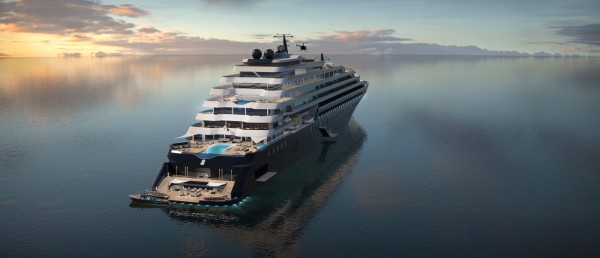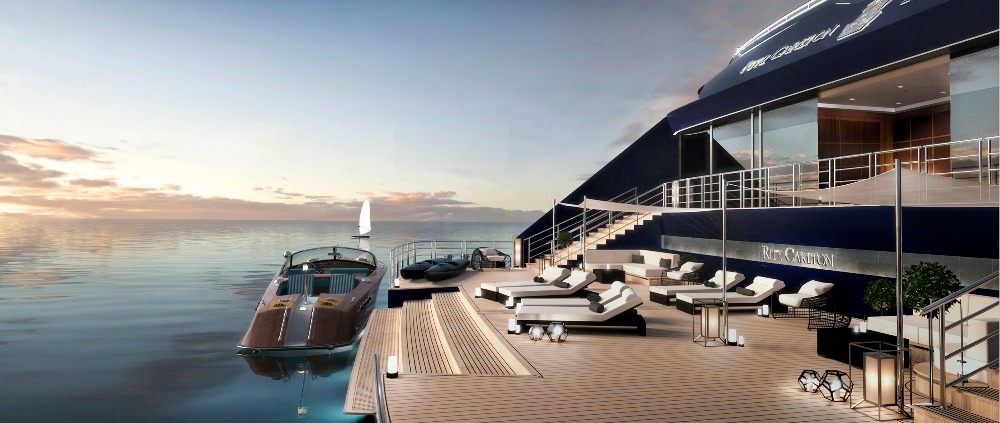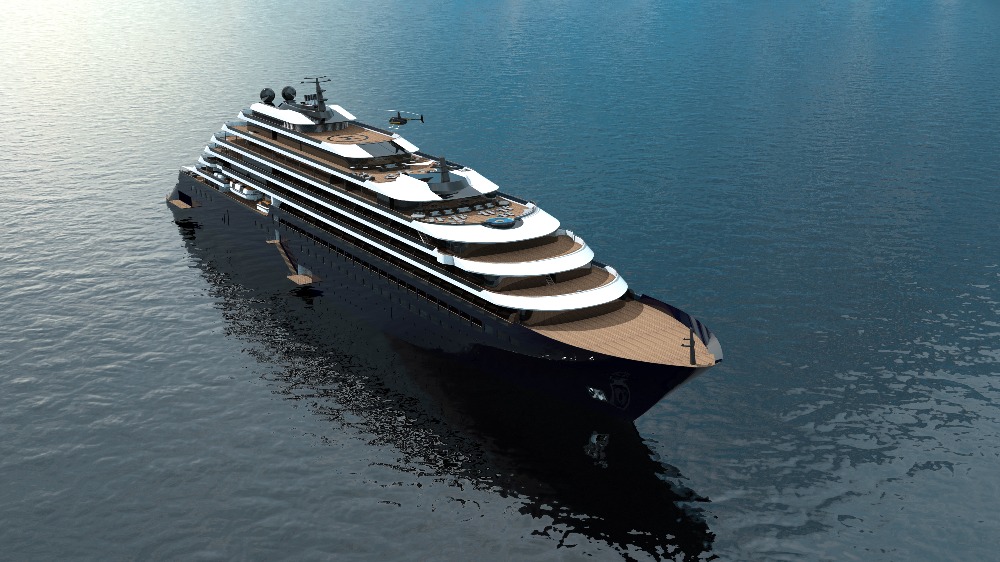Superyacht vs luxury cruise ship building
SuperyachtNews asks why the two sectors vary so significantly in build time and costs…
Due to the growing demand for high-end cruises with unique itineraries, a number of luxury cruise ships are currently under construction for well-known travel and hospitality brands. While maintaining high-quality exterior and interior design, these vessels are being built significantly cheaper and faster than superyachts. Silversea Cruises’ luxury ship Silver Moon, currently in build at Fincantieri, has a volume of 40,700gt, will cost €310 million and will be delivered in 2020. This equates to a build cost of €7,617 per gross ton and an estimated build time of three years.
Using an example from the brokerage market purely for comparative reasons, at the time of writing Rossinavi’s 50m Endurance project had an asking price of €27.5 million. With a gross tonnage of 499, this means a build cost of approximately €55,960 per gross ton – more than seven times the price per gross ton of Silver Moon. While this is just one example and, of course, the build cost of a superyacht per gross ton varies greatly – depending on factors such as the yard, designer and level of customisation – these figures give some idea of just how much more time and money it takes to build a superyacht compared to a luxury cruise ship.
It goes without saying that there is a big difference in the two types of vessels' purpose and, in particular, how superyachts are expected to be built and finished, especially in terms of fairing, painting and interior design. The finish and quality of a superyacht is much more luxurious than even that of the most luxurious cruise ship; but does this really justify such a significant difference in time and cost?
“Most superyachts are completely custom-made from the engineering to final outfitting, while cruise ships are usually built based on already existing and tested platforms...”
Having completed the conversion project of standard cruiseliner Silver Cloud into a luxury expedition cruise ship in 2017, Palumbo Shipyard Malta has experience in both luxury cruise-ship and superyacht projects. The $46.5 million project was conceived in response to the demand for more luxury polar expeditions from Silversea Cruises. Taking its oldest ship in the fleet out of commission for only 65 days, an army of 400 worked around the clock at the shipyard to get it ready. As well as a new, strengthened bow and resurfaced hull for polar cruising, Silver Cloud’s refit saw transformed luxury interiors with suite accommodation and private balconies.
Andrea Sabbion, Palumbo Group’s sales manager – commercial ships division, believes that while the new-build market for small, luxury cruise ships and the new-build market for superyachts certainly have some elements in common, there are also remarkable differences. “Some of the world’s top luxury cruise brands, such as Crystal Cruises, Seabourn, Silversea, Regent Seven Seas and Ritz-Carlton, will soon launch ultra-luxury ships employed on special itineraries and spacious, open-concept design schemes that will revolutionise the traditional cruise experience. In fact, many of these ships are being referred to as ‘megayachts’ in order to have a marketing impact on potential customers.”
The design of the latest luxury cruise vessel is usually slender, long and elegant – completely different from a traditional cruise vessel and more in line with that of a superyacht. One example is the latest Ritz-Carlton ‘Yacht Collection’, currently in build at the Barreras Shipyard in Vigo, Spain. Each yacht will have 149 suites, all of which feature a private balcony, and like many current superyacht designs, the vessels will also have a beach-club platform that will offer direct access to the water. As the Ritz-Carlton team hopes to attract complete buyouts of the yachts for private charters, the vessels have been designed with an innovative wall system so that room layouts can be modified to suit the purpose of each voyage.

“These 190m vessels are the perfect hybrids between ultra-luxury small ships and yachts,” adds Sabbion. “If small cruisers carry about 650 passengers on average, and a typical superyacht can hold a dozen, then these luxury cruise vessels are right in between, with 298 passengers in 149 suites. The interior spaces have been restudied with the focus being to accommodate enormous state-rooms and an abundance of dining options, amenities and public spaces, avoiding discomforts such as queues, crowds and disturbances.”
In this sense, therefore, luxury cruise ships are moving closer to superyachts while superyachts are getting closer to cruise ships. The 167m M/Y Eclipse, for example, is nothing less than a modern cruise vessel in terms of dimensions, propulsion systems, in-board systems and plants, safety and security systems and on-board entertainment technology. However, for a number of reasons, building a luxury cruise vessel is significantly cheaper and less time consuming than building a similar superyacht.
Andrea Qualizza, project manager of luxury cruise ship Silver Muse, delivered by Fincantieri in April 2017, explains that for luxury cruise ships, many standard installation procedures from the bigger cruise-ship market can be replicated, therefore making the build process much more efficient. “All systems relating to the electrical, piping and automation side of the ship have the same technical requirements as a bigger vessel,” explains Qualizza. “The only big difference is in the design and finish of the public spaces and cabins, but we then use the same industrial processes as a large cruise ship.”
Most of the time and money that goes into a superyacht build are in the places you can’t see...
“Most superyachts [of equivalent size] are completely custom-made from the engineering to final outfitting, while cruise ships are usually built based on already existing and tested platforms,” agrees Sabbion. “Secondly, the level of details and finishing is still incomparable between the two concepts. Building the hull is a similar process on both – we conduct the hull prefab in different modules and assemble for both types of projects – but the big difference is in the surface preparation because of the details and quality. On superyacht projects, for example, no welding must be visible, there is 100 per cent fairing – it’s a different level of quality and look which requires much more time and money.”
Considering that the structure and hull of a yacht represent only about 10 per cent of the total build cost, it is easy to understand how the prices and build times can vary between a superyacht and luxury cruise ship. While the production and semi-custom superyacht market can benefit in time and cost from existing and tested platforms, and even full custom yachts can be built with already proven hull and engineering platforms, most of the time and money that goes into a superyacht build are in the places you can’t see. This includes the glossy white-painted plumbing, piping bilges and engine rooms, the polished stainless steel over the exhaust insulation and chrome kits on engines; all are expected on a superyacht but not on a luxury cruise ship.
A luxury cruise ship may, on the surface, appear to have the design and level of quality verging on that of a superyacht, but these vessels are still commercial entities. A luxury cruise-ship operator is not willing to waste time and money on elements of the build that do not make a difference to the overall experience of the guests as it would reduce their bottom line. This means less customisation, less attention to detail and the acceptance of an imperfect finish. Superyachts, on the other hand, are much more individual and built for clients who want nothing short of perfection in every nook and cranny of the yacht. Even those built for commercial use have superyacht clientele in mind, who also expect the same standard. For this simple reason, it is extremely difficult to compare the new-build markets for both types of vessel – they simply do not overlap when it comes to anything above the hull.
This is a preview to the full feature, which appears in issue 184 of The Superyacht Report, out now.
Profile links
Click here to become part of The Superyacht Group community, and join us in our mission to make this industry accessible to all, and prosperous for the long-term. We are offering access to the superyacht industry’s most comprehensive and longstanding archive of business-critical information, as well as a comprehensive, real-time superyacht fleet database, for just £10 per month, because we are One Industry with One Mission. Sign up here.





